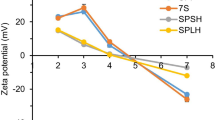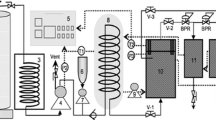Abstract
The effects of hydrothermal cooking on the functional properties of defatted soy flour, aqueous alcohol washed soy protein concentrate, and soy protein isolate were determined in samples that were treated at 154°C by infusing steam under pressure for 11, 19, 30, and 42 s, and then spray dried. Hydrothermal cooking increased the nitrogen solubility index (NSI) of the concentrate from 15 to 56% and altered the solubility profile from a flat profile to one more typical of native soy protein. Hydrothermal cooking also improved foaming and emulsifying properties of the concentrate. For isolate, hydrothermal cooking also improved NSI and foaming and emulsifying properties, although the improvements were less dramatic than with concentrate. NSI and emulsifying properties of the flour were improved by some processing conditions, but foaming properties were not improved by hydrothermal cooking. Dramatically increased protein solubility of concentrate and modestly improved protein solubilities of flour and isolate by hydrothermal cooking, which will also inactivate trypsin inhibitors and microorganisms, have considerable practical significance to protein ingredient manufacturers and those who use these ingredients in foods and industrial products.
Similar content being viewed by others
References
Smith, A.K., and S.J. Circle, in Soybeans: Chemistry and Technology, edited by A.K. Smith and S.J. Circle, AVI Publishing Co., Westport, CT, 1976, p. 339.
Kinsella, J.E., S. Damodaran, and B. German, Physicochemical and Functional Properties of Oilseed Proteins with Emphasis on Soy Proteins, in New Protein Foods, Vol. 5, Seed Storage Proteins, edited by A.M. Altschul and H.L. Wilcke, Academic Press, New York, 1985, p. 107–179.
Wolf, W.J., and J.C. Cowan, Soybeans as a Food Source, CRC Press, Miami, 1976, p. 30.
Johnson, L.A., C.W. Deyoe, and W.J. Hoover, Soymilk Process, U.S. Patent 4,409,256 (1981).
Johnson, L.A., C.W. Deyoe, and W.J. Hoover, Yield and Quality of Soymilk Processed by Steam-Infusion Cooking, J. Food Sci. 46:239–243 (1981).
Johnson, L.A., Processing Aqueous Extracts of Soybeans by Rapid-Hydration Hydrothermal Cooking, Ph.D. Thesis, Kansas State University, Manhattan, 1978, pp. 1–185.
Johnson, L.A., C.W. Deyoe, W.J. Hoover, and J.R. Schwenke, Inactivation of Trypsin Inhibitors in Aqueous Extracts of Soybean by Direct Steam Infusion, Cereal Chem. 57:376–379 (1980).
Hung, J.S., Studies on Processing, Functional Characteristics and Nutritional Quality of Hydrothermal Extracts of Soybeans, Ph.D. Dissertation, Kansas State University, Manhattan, 1984, pp. 1–199.
Kim, C.J., Physico-Chemical, Nutritional, and Flavor Properties of Soybean Extracts Processed by Rapid-Hydration Hydrothermal Cooking, Ph.D. Dissertation, Iowa State University, Ames, 1988, pp. 1–122.
Nakai, S., and E. Li-Chen, Effects of Heating on Protein Functionality, in Protein Quality and the Effects of Processing, edited by R.D. Dixon and J.W. Finley, Marcel Dekker, New York, 1989.
Official and Tentative Methods of the American Oil Chemists’ Society, 3rd edn., edited by D. Firestone, American Oil Chemists’ Society, Champaign, 1991.
Hamada, J.S., and W.E. Marshall, Preparation and Functional Properties of Enzymatically Deamidated Soy Protein, J. Food Sci. 54:598–601, 635 (1989).
Lin, M.J.Y., E.S. Humbert, and F.W. Sosulski, Certain Functional Properties of Sunflower Meal Products, J. Food Sci. 39:368–370 (1974).
Official Methods of Analysis of the Association of Official Analytical Chemists, 15th edn., edited by K. Helrich, Association of Official Analytical Chemists, Arlington, 1990.
Wang, J.C., and J.E. Kinsella, Functional Properties of Novel Proteins: Alfalfa Leaf Protein, J. Food Sci. 41:286–292 (1976).
Kato, A., Y. Osaka, N. Matsudomi, and K. Kobayashi, Changes in the Emulsifying and Foaming Properties of Proteins During Heat Denaturation, Agric. Biol. Chem. 47:33–37 (1983).
Approved Methods of the American Association of Cereal Chemists, 8th edn., American Association of Cereal Chemists, St. Paul, 1983.
Author information
Authors and Affiliations
Corresponding author
About this article
Cite this article
Wang, C., Johnson, L.A. Functional properties of hydrothermally cooked soy protein products. J Amer Oil Chem Soc 78, 189–195 (2001). https://doi.org/10.1007/s11746-001-0242-y
Received:
Accepted:
Issue Date:
DOI: https://doi.org/10.1007/s11746-001-0242-y




